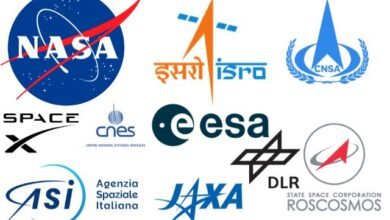Space Debris Insights from Astroscale and Amazon’s Carbon Emission Trajectory
Astroscale Japan's ADRAS-J spacecraft captured striking images of a discarded upper stage rocket body just 50 meters away.

Images captured from just 50 meters away have allowed Astroscale Japan to present a close-up picture of space junk. Images of a Japanese H-2A rocket’s upper stage that is now orbiting the Earth are shown here. During the ADRAS-J satellite’s initial fly-around of the debris, Astroscale made following observations.
Launched on February 18, ADRAS-J aims to gather data for future missions focused on larger-scale space debris removal. Its successful test of an autonomous collision avoidance system enabled months of monitoring of the rocket’s upper stage. Now that these images are public, it’s evident ADRAS-J can safely approach debris for detailed observations.
The latest fly-around images offer the clearest view yet of the abandoned H-2A upper stage rocket body. Currently orbiting Earth, this rocket last launched the GOSAT Earth-observation satellite in 2009. It measures approximately eleven meters (36 feet) in length, four meters (13 feet) in diameter, and weighs roughly three tons. These images underscore the ongoing issue of space debris long after its primary mission.
Amazon pledged in 2019 to achieve carbon neutrality by 2040. However, its carbon footprint soared from over 51 million metric tons in 2019 to more than 71 million metric tons in 2021. Recently, there has been a slight improvement, with emissions expected to decrease by 3% in 2023 to just under 69 million metric tons of CO2.
To put this in perspective, yearly CO2 output of 184 gas-fired power plants was equal to Amazon’s carbon footprint in 2023. Amazon is still producing 34% more carbon than it did in 2019—year it set its climate commitment—despite decline. This decrease is significant, especially considering that emergence of new AI technology led to increases in emissions at other IT companies.
Amazon attributes its recent reduction in carbon emissions to cutting its electricity use by 11% & its indirect supplier chains by 5%. Additionally they have fulfilled their objective of using only renewable energy sources to match 100% of their electricity usage by 2023—seven years ahead of schedule.
It is important to know what is meant by “matching”. Worldwide supply of renewable energy is currently insufficient to achieve climate goals, thus it entails using Renewable Energy Certificates (RECs) to fund renewable energy projects. RECs fill the gap left by Amazon’s inability to guarantee that power it uses from the grid is sourced sustainably.
The quality of RECs matters. If they become too cheap, they don’t provide enough incentive for new clean energy projects. Research in 2022 found that many companies have overestimated their carbon emission reductions through RECs. What’s really needed are new, additional sources of renewable energy.
To address this, companies like Microsoft and Google aim to match their electricity use with locally generated clean energy on an hourly basis rather than annually. This approach supports a future with enough renewable energy to rely on 24/7 on any grid a company uses.
Another option is to enter Power Purchase Agreement (PPA), a long-term contract to support and purchase electricity from clean energy project. Amazon is the largest corporate purchaser of renewable energy, buying more solar and wind power through PPAs than Google and Microsoft combined, according to BloombergNEF.
In contrast, Google and Microsoft saw their greenhouse gas emissions increase by about 13 and 20 percent, respectively, last year as they integrated AI into their products and services. Both companies have experienced larger increases since setting climate goals. Microsoft’s carbon footprint was 30 percent larger in its 2023 fiscal year than in 2020, according to its latest sustainability report. Google’s emissions were 48 percent higher in 2023 compared to 2019. While Amazon is also incorporating AI into Alexa & other services, it is reportedly trying to catch up with other major players in AI field.
According to Bloomberg, Amazon experienced a 13 percent decrease in emissions from capital goods last year, which included new servers, buildings, cars, and other equipment. In 2023, the company’s capital expenditures decreased by almost $10 billion. Carbon emissions increased due to Amazon’s expansion during the COVID-19 epidemic. But now that warehouse and data center expenses have decreased, so have its emissions.
- SpaceX Falcon 9 Rocket Grounded After Launch Failure: Investigation Underway
- A Dune-inspired spacesuit turns astronaut pee into drinking water
- Scientists SHUDDER! Milky Way’s Dark Secret: A BLACK HOLE We Never Knew Existed!
FAQ: Space Debris Insights from Astroscale and Amazon’s Carbon Emission Trajectory
1. What is space debris?
Space debris, or space junk, includes any human-made objects orbiting Earth that no longer serve a purpose, like defunct satellites, rocket stages, and fragments from collisions.
2. Why is space debris a problem?
Space debris poses a threat to operational spacecraft. Even small debris pieces traveling at high speeds can cause significant damage or destruction, leading to more debris and increasing future collision risks.
3. What is Astroscale doing about space debris?
Astroscale is developing technologies to remove space debris from orbit. Their missions involve capturing debris with specialized spacecraft and safely deorbiting them back into Earth’s atmosphere where they burn up.
4. How does Amazon’s carbon emission trajectory relate to space debris?
While not directly linked, both represent sustainability challenges. Cleaning up space debris requires rocket launches, which contribute to carbon emissions. Balancing debris removal and minimizing environmental impacts of launches is crucial.
5. What are some solutions to the space debris problem?
- Developing better practices for spacecraft disposal: Designing satellites to deorbit themselves or using materials that burn up easily in the atmosphere.
- Active debris removal (ADR): Companies like Astroscale are working on technologies to capture and deorbit existing debris.
- International cooperation: Collaboration between spacefaring nations is needed to develop regulations and implement solutions.
6. What can I do to help?
- Stay informed about space debris issues.
- Support organizations working on solutions.
- Advocate for policies promoting sustainable space activities.



